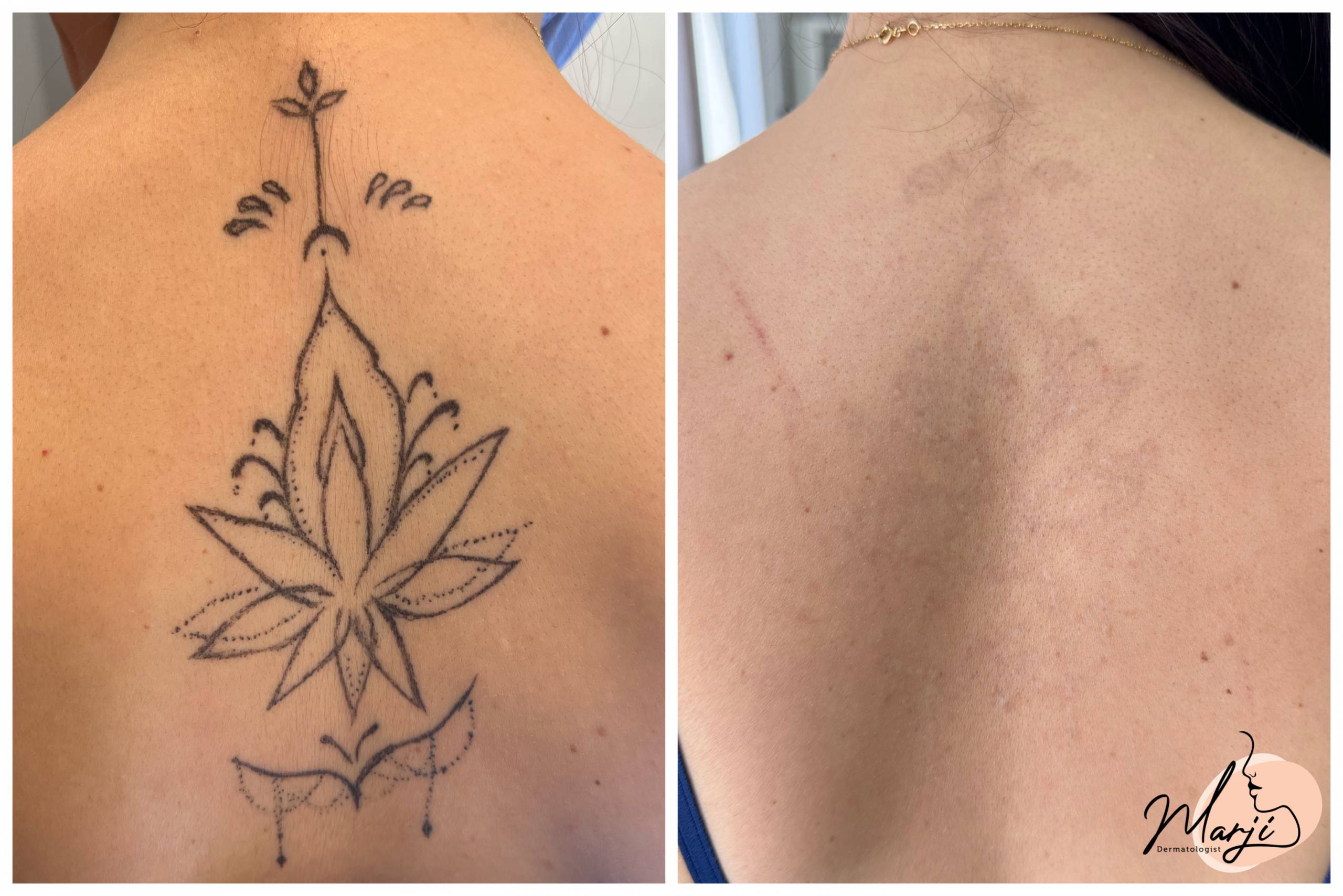You should think twice before getting a random tattoo as removing it can be a long journey. Usually, tattoo removal by laser is done through multiple sessions that might take several months, sometimes even up to a year.
Tattoo removal laser produces pulses of light energy. Each pulse of this light energy penetrates the skin and gets absorbed by the tattoo ink. The tattoo ink particles then absorb the light energy, heat up, then shatter into tiny fragments. Over the weeks following treatment, your immune system flushes the tattoo ink particles away from the location, which gives the tattoo a faded appearance. Each laser treatment session breaks more of the tattoo ink until none remain.
How the Procedure Is Done
The procedure of tattoo removal by laser is not too complicated, and there are fixed steps that your doctor will take you through to remove your tattoo. Here is what you can expect to happen during a tattoo removal session:
- The dermatologist will apply local anesthesia or use cooling device during the session to control the pain.
- You will be given an eye shield to wear to protect your eyes from the laser light.
- Your doctor will test your skin’s reaction to the laser to determine the most effective energy to use.
- The doctor will use the laser to pass pulses through the top layers of your skin that will be absorbed by the tattoo pigment only, as the target will be frosting on the tattoo which means it becomes slightly white after the pulse, and this temporary change lasts for few minutes.
- A healing cream is applied to the treated area following the session. After that, the area will be covered to protect it from elements.
Side Effects of Tattoo Laser Removal
Tattoo removal is not the easiest or painless procedure to go through. It can involve some complications and a number of side effects, including:
- Pain: You should expect a little pain and discomfort during and after the tattoo removal procedure as it involves a relatively high-fluence laser. Some patients describe the pain similar to getting the tattoo.
- Swelling: It is common to expect some swelling in the treated area following the session. The swelling usually lasts for few hours to few days depending on the size and site of the tattoo.
- Blisters: Blistering after laser tattoo removal might happen, when using high settings, this heals withing few days.
- Hyperpigmentation of the tattoo: If you have just started tattoo removal and see that your tattoo appears darker, that means it’s working. The oxidation occurring from the metals in the tattoo ink will turn darker as the ink is broken down under your skin.
- Scars: this might happen from using high fluence setting. Sometimes tattooing the skin by needles and when removing the ink by laser the scaring form the tattooing becomes more noticeable.
- Hypopigmentation: You may end up with hypopigmentation after the tattoo removal session, which means the skin where the tattoo is will become lighter than the skin surrounding it.
- lumbs and pumps: a rear reaction might happen which is foreign body granuloma as your immune system is aggressively reacting to the tattoo material.
- Increased risk of infection: Your skin could become infected after tattoo removal. Talk to your doctor if this happens so that they can help you treat the infection as effectively as possible.
How Many Sessions Do You Need
The number of sessions you could need to remove your tattoo might range from 3 to 15 sessions depending on several factors, including:
- The color of the tattoos: The easiest colors to remove are black, green, and blue. Meanwhile, colors like red might take more sessions. Yellow and beige removal is by far the hardest.
- Duration of the tattoo: Simply put, the older your tattoo is, the easier it is to be removed.
- Depth of the tattoo: The more superficial the tattoo is, the easier it is to be removed. For example, micro-blading tattoos are relatively easier to remove than other types of tattoos.
- The material of the tattoo: Tattoo removal ease would differ depending on the material used to draw the tattoo.
- Skin color of the patient: The darker the skin of the patient, the harder the tattoo to remove is as the doctor use lower settings to avoid affecting the melanocytes and causing hypo-pigmentation.
What to Do after the Tattoo Removal Session
There is a number of things you can do after the tattoo removal session to guarantee a healthy healing process. Here is what you can do:
- Apply moisturizing creams to promote healing.
- avoiding showering or applying water on the same day
- Do not rub the treated area.
- Apply a good amount of sunblock to exposed areas before going out to avoid sunburns.
- you can oral pain killer like panadol or ibuprofen to manage the pain.
What Laser Machine Is Used in Our Clinic
Our clinic uses Picostar laser machine from Asclepion which is one of the best laser devices in the world for tattoo removal. This device has many unique features including:
- It has the Pico energy technology.
- It contains both Ruby and ND: YAG wavelength lasers.
- Has programmed settings for tattoo removal, and permanent makeup removal.
- Has the ability to remove colored tattoos including black, green, blue, and even red tattoos.
- Less number of sessions is needed compared to Q-switched laser.
- we have the fractionated hand piece for faster results and better skin quality outcome.
What is the interval between the sessions
Usually anytime from 6-8 weeks, we might do some exceptions for shorter interval of 4 weeks for micro-blading or customization for our patients due to travel. the improvement after a single sessions lasts for months.
who perform the procedure
The procedure is performed by doctor Maha Marji personally, as she’s a board certified dermatologist and laser specialist, who has great interest in the laser. she received her advanced training on this device at Asclepion factory in Germany.
Book your appointment today to have your tattoo removed by calling our clinic at 079 111 2222.


